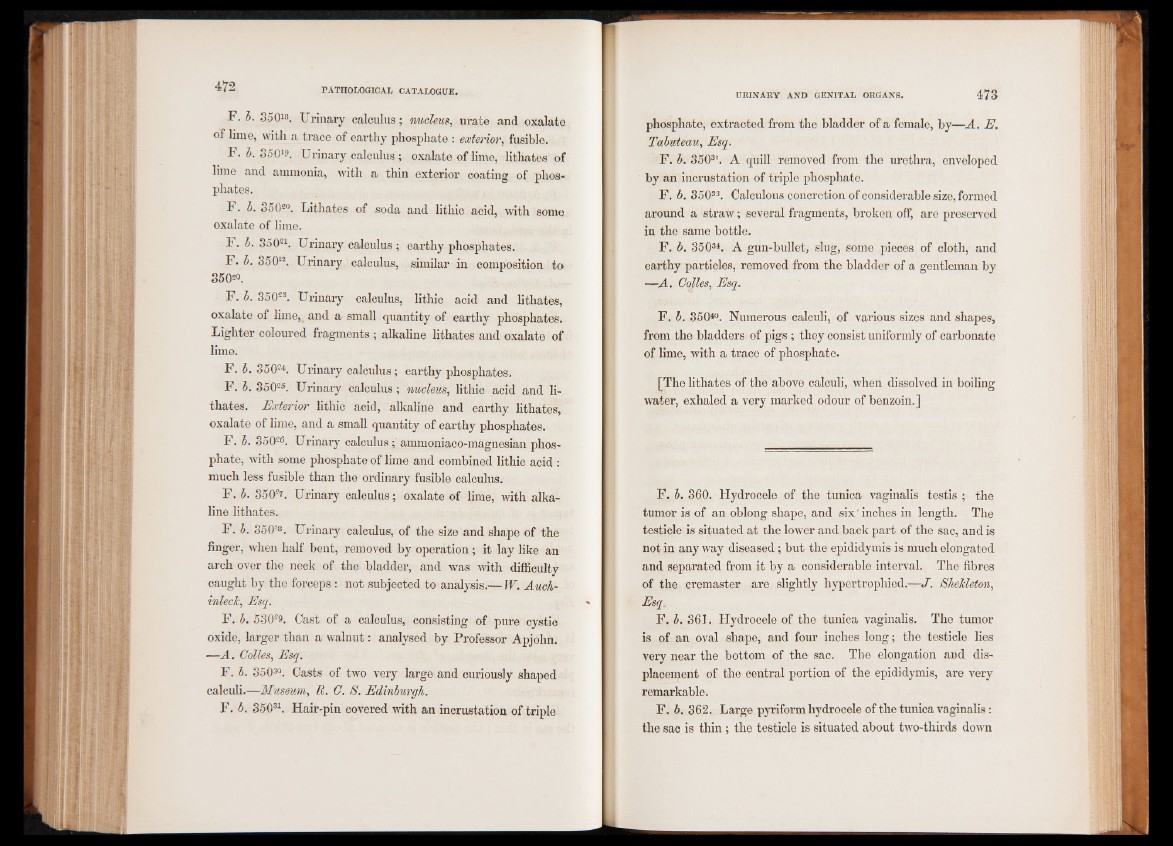
F. b. 35018. Urinary calculus; nucleus, urate and oxalate
of lime, with a trace of earthy phosphate : exterior, fusible.
F. b. SSO^. Urinary calculus; oxalate of lime, lithates of
lime and ammonia, with a thin exterior coating of phosphates.
F. b. 35020. Lithates of soda and lithic acid, with some
oxalate of lime.
F. b. 35021. Urinary calculus ; earthy phosphates.
F. b. 350s®. Urinary calculus, similar in composition to
35020.
F. b. 35023. Urinary calculus, lithic acid and lithates,
oxalate of lime,, and a small quantity of earthy phosphates.
Lighter coloured fragments ; alkaline lithates and oxalate of
lime.
F. b. 35024. Urinary calculus; earthy phosphates.
F. 5. 35025. Urinary calculus; nucleus, lithic acid and lithates.
Exterior lithic acid, alkaline and earthy lithates,
oxalate of lime, and a small quantity of earthy phosphates.
F. b. 85026. Urinary calculus; ammoniaco-magnesian phosphate,
with some phosphate of lime and combined lithic acid :
much less fusible than the ordinary fusible calculus.
F. b. 3502r. Urinary calculus; oxalate of lime, with alkaline
lithates.
F. b. 350?8. Urinary calculus, of the size and shape of the
finger, when half bent, removed by operation; it lay like an
arch over the neck of the bladder, and was with difficulty
caught by the forceps : not subjected to analysis.— W. Auch-
inleck, Esq.
F. b. 53029. Cast of a calculus, consisting of pure cystic
oxide, larger than a walnut: analysed by Professor Apjohn.
—A. Colies, Esq.
F. b. 35030. Casts of two very large and curiously shaped
calculi.—Museum, R. C. S. Edinburgh.
F. b. 35031. Hair-pin covered with an incrustation of triple
phosphate, extracted from the bladder of a female, by—A. E.
Tabuteau, Esq.
F. b. 35032. A quill removed from the urethra, enveloped
by an incrustation of triple phosphate.
F. b. 35033. Calculous concretion of considerable size, formed
around a straw; several fragments, broken off, are preserved
in the same bottle.
F. b. 35 03*. A gun-bullet, slug, some pieces of cloth, and
earthy particles, removed from the bladder of a gentleman by
—A. Cojles, Esq.
F. b. 35040. Numerous calculi, of various sizes and shapes,
from the bladders of pigs ; they consist uniformly of carbonate
of lime, with a trace of phosphate.
[The lithates of the above calculi, when dissolved in boiling
water, exhaled a very marked odour of benzoin.]
F. b. 360. Hydrocele of the tunica vaginalis testis ; the
tumor is of an oblong shape, and six' inches in length. The
testicle is situated at the lower and back part of the sac, and is
not in any way diseased; but the epididymis is much elongated
and separated from it by a considerable interval. The fibres
of the cremaster are slightly hypertrophied.—J. Shekleton,
Esq.
F. b. 361. Hydrocele of the tunica vaginalis. The tumor
is of an oval shape, and four inches long; the testicle lies
very near the bottom of the sac. The elongation and displacement
of the central portion of the epididymis, are very
remarkable.
F. b. 362. Large pyriform hydrocele of the tunica vaginalis:
the sac is thin; the testicle is situated about two-thirds down